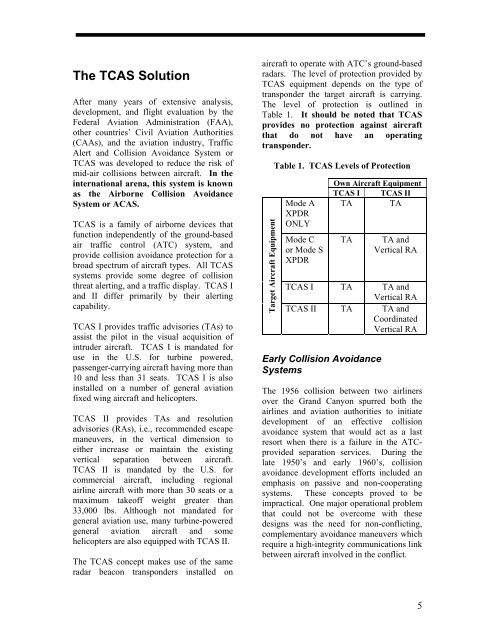You also want an ePaper? Increase the reach of your titles
YUMPU automatically turns print PDFs into web optimized ePapers that Google loves.
The <strong>TCAS</strong> Solution<br />
After many years of extensive analysis,<br />
development, and flight evaluation by the<br />
Federal Aviation Administration (FAA),<br />
other countries’ Civil Aviation Authorities<br />
(CAAs), and the aviation industry, Traffic<br />
Alert and Collision Avoidance System or<br />
<strong>TCAS</strong> was developed to reduce the risk of<br />
mid-air collisions between aircraft. In the<br />
international arena, this system is known<br />
as the Airborne Collision Avoidance<br />
System or ACAS.<br />
<strong>TCAS</strong> is a family of airborne devices that<br />
function independently of the ground-based<br />
air traffic control (ATC) system, and<br />
provide collision avoidance protection for a<br />
broad spectrum of aircraft types. All <strong>TCAS</strong><br />
systems provide some degree of collision<br />
threat alerting, and a traffic display. <strong>TCAS</strong> I<br />
and <strong>II</strong> differ primarily by their alerting<br />
capability.<br />
<strong>TCAS</strong> I provides traffic advisories (TAs) to<br />
assist the pilot in the visual acquisition of<br />
intruder aircraft. <strong>TCAS</strong> I is mandated for<br />
use in the U.S. for turbine powered,<br />
passenger-carrying aircraft having more than<br />
10 and less than 31 seats. <strong>TCAS</strong> I is also<br />
installed on a number of general aviation<br />
fixed wing aircraft and helicopters.<br />
<strong>TCAS</strong> <strong>II</strong> provides TAs and resolution<br />
advisories (RAs), i.e., recommended escape<br />
maneuvers, in the vertical dimension to<br />
either increase or maintain the existing<br />
vertical separation between aircraft.<br />
<strong>TCAS</strong> <strong>II</strong> is mandated by the U.S. for<br />
commercial aircraft, including regional<br />
airline aircraft with more than 30 seats or a<br />
maximum takeoff weight greater than<br />
33,000 lbs. Although not mandated for<br />
general aviation use, many turbine-powered<br />
general aviation aircraft and some<br />
helicopters are also equipped with <strong>TCAS</strong> <strong>II</strong>.<br />
The <strong>TCAS</strong> concept makes use of the same<br />
radar beacon transponders installed on<br />
aircraft to operate with ATC’s ground-based<br />
radars. The level of protection provided by<br />
<strong>TCAS</strong> equipment depends on the type of<br />
transponder the target aircraft is carrying.<br />
The level of protection is outlined in<br />
Table 1. It should be noted that <strong>TCAS</strong><br />
provides no protection against aircraft<br />
that do not have an operating<br />
transponder.<br />
Target Aircraft Equipment<br />
Table 1. <strong>TCAS</strong> Levels of Protection<br />
Mode A<br />
XPDR<br />
ONLY<br />
Mode C<br />
or Mode S<br />
XPDR<br />
Own Aircraft Equipment<br />
<strong>TCAS</strong> I <strong>TCAS</strong> <strong>II</strong><br />
TA TA<br />
TA<br />
TA and<br />
Vertical RA<br />
<strong>TCAS</strong> I TA TA and<br />
Vertical RA<br />
<strong>TCAS</strong> <strong>II</strong> TA TA and<br />
Coordinated<br />
Vertical RA<br />
Early Collision Avoidance<br />
Systems<br />
The 1956 collision between two airliners<br />
over the Grand Canyon spurred both the<br />
airlines and aviation authorities to initiate<br />
development of an effective collision<br />
avoidance system that would act as a last<br />
resort when there is a failure in the ATCprovided<br />
separation services. During the<br />
late 1950’s and early 1960’s, collision<br />
avoidance development efforts included an<br />
emphasis on passive and non-cooperating<br />
systems. These concepts proved to be<br />
impractical. One major operational problem<br />
that could not be overcome with these<br />
designs was the need for non-conflicting,<br />
complementary avoidance maneuvers which<br />
require a high-integrity communications link<br />
between aircraft involved in the conflict.<br />
5



